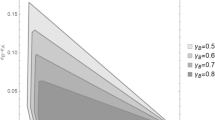Abstract
This paper considers the prospect that multiproduct firms facing each other in separate markets might tacitly coordinate their production through strategic common service cost allocations and mutually benefit from such action as a consequence. Our analysis suggests that decentralization cum tacit coordination may be possible in equilibrium, with or without public disclosure of allocation choices. In turn, tacit coordination may contribute to explanations for multiproduct firms' decisions to decentralize. The implications for trade oversight bodies are ambiguous. While tacit coordination results in an anti-competitive distortion toward monopolies, it also induces greater specialization which reduces the diseconomies of scope.
Similar content being viewed by others
References
Allaz, B. (1992). “Oligopoly, Uncertainty and Strategic Forward Transactions.” International Journal of lndustrial Organization 10, 297–308.
Alles, M., and S. Datar. (1995). “Transfer Pricing and Strategic Product Costing.” Working paper, University of Texas at Austin.
Bagwell, K. (1995). “Commitment and Observability in Games.” Games and Economic Behavior 6, 271–280.
Banker, R. D., and J. S. Hughes. (1994). “Product Costing and Pricing.” The Accounting Review 69(3), 479–494.
Brandenburger, A. M., and B. J. Nalebuff. (1996). Co-opetition. New York: Doubleday.
Brander, J. A., and J. R. Lewis. (1986). “Oligopoly and Financial Structure: The Limited Liability Effect.” American Economic Review 76(5), 956–970.
Brander, J. A., and B. J. Spencer. (1983). “Strategic Commitment with R&D: The Symmetric Case.” Bell Journal of Economics 14(1), 225–235.
Bulow, J., J. Geanakoplos, and P. Klemperer. (1985). “Multimarket Oligopoly: Strategic Substitutes and Complements.'' Journal of Political Economy 93, 488–511.
Cavalluzzo, K. S., C. D. Ittner, and D. F. Larcker. (1997). “Competition and Cost Allocation Changes in Government Agencies: Evidence of the Federal Reserve.” Working paper, University of Pennsylvania.
Edwards, C. D. (1955). “Conglomerate Bigness as a Source of Power.” Business Concentration and Price Policy,NBER Conference Report, Princeton: Princeton University Press.
Fershtman, C., and K. Judd. (1987). “Equilibrium Incentive in Oligopoly.” American Economic Review 77(5), 927–940.
Gal-Or, E. (1993). “Strategic Cost Allocation.” The Journal of Industrial Economics XLI (December), 387–402.
Hansen, S. C., and R. P. Magee. (1993). “Capacity Cost and Capacity Allocations.” Contemporary Accounting Research 9(Spring), 635–660.
Holmstrom, B., and P. Milgrom. (1987). “Aggregation and Linearity in the Provision of Intertemporal Incentives.” Econometrica 55, 303–328.
Hughes, J. S., and J. L. Kao. (1997). “Strategic Forward Contracting and Observability.” International Journal of Industrial Organization 16, 121–133.
Hughes, J. S., and J. H. Scheiner. (1980). “Efficiency Properties of Mutually Satisfactory Cost Allocations.” The Accounting Review 55(1), 85–95.
Jensen, D. L. (1977). “A Class of Mutually Satisfactory Allocations.” The Accounting Review (October), 842–856.
Kaplan, R., and G. Thompson. (1971). “Overhead Allocation via Mathematical Programming Models.” The Accounting Review (April), 352–364.
Magee, R. P. (1988). “Variable Cost Allocation in a Principal/Agent Setting.” The Accounting Review 63(1), 42–54.
Porter, M. E. (1985). Competitive Advantage. New York, NY: The Free Press.
Rajan, M. V. (1992). “Cost Allocation in Multiagent Settings.” The Accounting Review 67(3), 527–545.
Schwartz, M., and E. A. Thompson. (1986). “Divisionalization and Entry Deterrence.” Quarterly Journal of Economics CI(2), 307–312.
Viscusi, W. K., J. M. Vernon, and J. E. Hanington, Jr. (1995). Economics of Regulation andAntitrust. Cambridge, MA: The MIT Press.
Zimmerman, J. (1979). “The Costs and Benefits of Cost Allocations.” The Accounting Review 54(3), 504–521.
Author information
Authors and Affiliations
Rights and permissions
About this article
Cite this article
Hughes, J.S., Kao, J.L. Cross-Subsidization, Cost Allocation, and Tacit Coordination. Review of Accounting Studies 2, 265–293 (1998). https://doi.org/10.1023/A:1018326914717
Issue Date:
DOI: https://doi.org/10.1023/A:1018326914717



